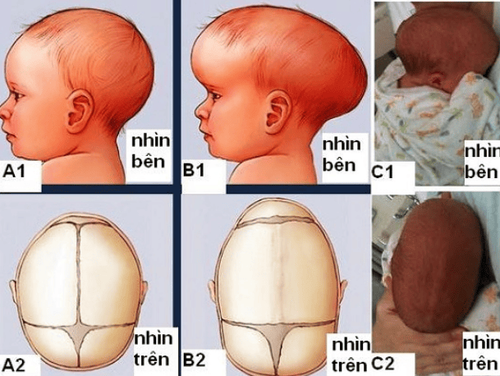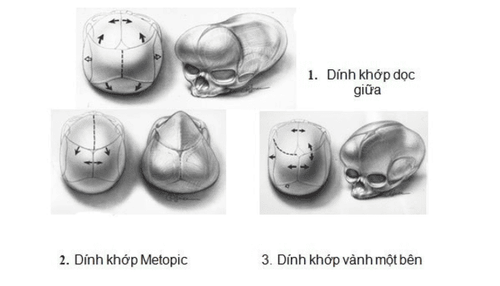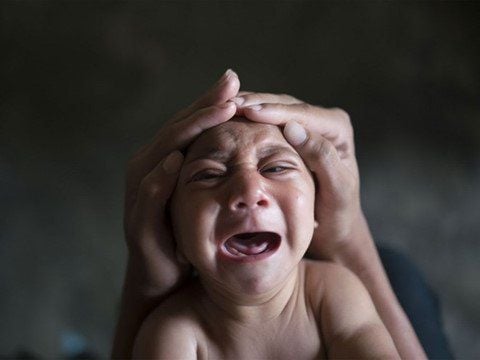This is an automatically translated article.
Ankylosing spondylitis is a dangerous disease that seriously affects the growth and development of sufferers. Early craniosynostosis, if not detected and treated promptly, will affect the patient's brain development, vision and mental-motor abilities.1. What is early craniosynostosis in children?
Early craniosynostosis in children (also known as craniosynostosis) is a rare disease (6 out of every 10,000 children on average). Premature craniosynostosis is a birth defect that occurs when the cranial sutures fuse together prematurely (premature closure). This early attachment is what causes the baby to have an abnormal skull shape because the bones do not expand normally as the brain develops.The malformation usually manifests in the fetal stage, characterized by deformity of the head shape and in some patients with facial deformity. The severity and type of deformity depends on which craniosynostosis is involved and at what point in development.
Ankylosing spondylitis deforms the skull in children. Depending on which joint is involved, the skull will develop compensatingly in a direction parallel to that joint line. From there, making the baby's head will be uneven but distorted, deformed in a certain direction. The most common type of craniosynostosis is a midline sagittal fusion, which causes the head to elongate in an anteroposterior direction, called a boat-shaped head defect. When one or both sides of the rim joint, the head will be bent to one side or flattened to the sides.
Ankylosing spondylitis deforms the face, the manifestation may be the uneven development of the two eyebrows, the eyes may bulge out, the nasal bone is deviated to one side. The craniofrontal fusion causes triangular head defects, the frontal bone develops strongly, causing the appearance of two forehead mounds that are excessively protruding compared to normal.
Types of early craniosynostosis include:
Coronal synostosis. Lamboidal synostosis. Bicoronal synostosis. Metopic synostosis. Sagittal synostosis.

Dính khớp sọ gây biến dạng hộp sọ ở người bệnh.
2. Causes of early craniosynostosis in children
The cause of craniosynostosis is mainly due to the craniofacial lines fused together in the fetus. Normally, these joints will attach together at 2-4 years of age and only become fully fused after the age of 20. There are two main mechanisms, that is, because of the disease of the skull bones (primary cranial fusion) or because of the failure of the brain to develop prematurely, the skull joints are closed (secondary craniosynostosis causing microcephaly). . Specifically:
Firstly, due to the pathology of the skull bones (primary craniosynostosis) deforms the child's skull. Depending on the joint that is involved, the skull will grow parallel to and compensate for that joint line. Common joints such as the middle longitudinal joint, the frontal joint, etc. These joints can be attached to one or more joint lines. Second, because the brain's pathology can't develop, the skull joints are closed prematurely (craniosynostosis secondary to microcephaly). The cranial joints between the bony plates that make up the skull stick together too early in infancy, restricting growth as well as giving the brain not enough space to grow and develop normally (resulting in microcephaly). ).

Nguyên nhân dính khớp sọ chủ yếu là do các đường khớp sọ dính với nhau từ trong bào thai.
3. Manifestations of craniosynostosis in children
Depending on the type of early craniosynostosis, there are different specific manifestations. However, the common manifestation of craniosynostosis is abnormal head shape and abnormal face. When joints are fused, the skull will grow compensatingly in a direction parallel to that joint line. As a result, the baby's head will be uneven but distorted in a corresponding direction. Specifically:
One-sided coronal synostosis: People with this synostosis show an anterior distortion of the head (head deformity). This can cause your baby's forehead to flatten out on one side. The eye socket on the fused side is pulled upwards, and the skull and nose are deviated to one side. Severe disease can lead to vision loss, blindness on the same side. These are the most recognizable signs of craniosynostosis. Bicoronal synostosis: This synostosis causes the patient to have a flattened forehead and eyebrows, raised as well as inward. Sagittal synostosis: The most common type of early craniosynostosis (60%, affects 3-5/1,000 live births and is more common in males). Because the premature closure of this joint leads to a condition called scaphocephaly, which causes the baby's head to elongate in an anteroposterior direction. Since the skull cannot extend to the sides, the baby has a protruding forehead. Lamboidal synostosis: This is a rare form of craniosynostosis. The patient will have distortion at the back of the head on one side, the mastoid is protruding, and the ear is deviated back. It can also cause the skull to distort to the side. This condition can be misdiagnosed as postural malformation. Metopic synostosis, 10%: Children with this synostosis will have trigonocephaly. This can cause the baby to have a pointed forehead, a raised bony ridge in the middle of the forehead, a triangular skull, and eyes that are too close together. Ankylosing spondylitis is a dangerous disease that seriously affects the growth and development of sufferers. Therefore, as soon as parents notice signs and causes of craniosynostosis in children, parents need to take the baby to a medical facility for timely examination.
As a key field, the Pediatrics Department - Vinmec International General Hospital always brings satisfaction to customers and is highly appreciated by industry experts with:
Gathering a team of leading doctors and nurses on Pediatrics: Including leading experts with high professional qualifications such as professors, associate professors, doctors, and masters with experience, who have worked at major hospitals such as Bach Mai, 108... All doctors are well-trained, professional, have a mind - range, and are knowledgeable about young psychology. In addition to domestic pediatricians, the Department of Pediatrics also has the participation of foreign experts such as Japan, Singapore, Australia, the US... who are always pioneers in applying new and effective treatment regimens. best. Comprehensive services: In the field of Pediatrics, Vinmec provides a series of continuous medical examination and treatment services from Newborn to Pediatric and Vaccine,... according to international standards to help parents take care of their baby's health from birth to childhood. Advanced techniques: Vinmec has successfully deployed many specialized techniques to make the treatment of difficult diseases in pediatrics more effective, such as neurosurgery - skull surgery, stem cell transplantation. hematopoiesis in cancer treatment. Professional care: In addition to understanding children's psychology, Vinmec also pays special attention to the children's play space, helping them to play comfortably and get used to the hospital's environment, cooperate in treatment, improve the efficiency of medical treatment.
Please dial HOTLINE for more information or register for an appointment HERE. Download MyVinmec app to make appointments faster and to manage your bookings easily.













